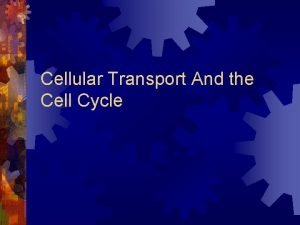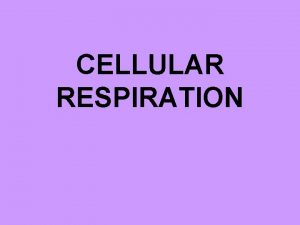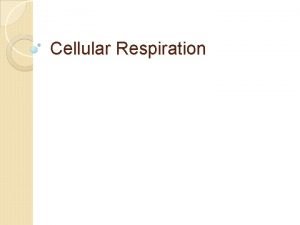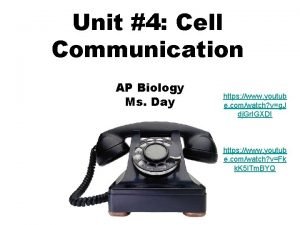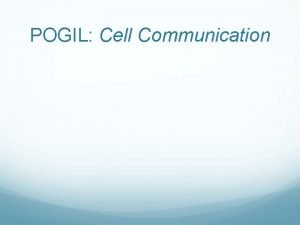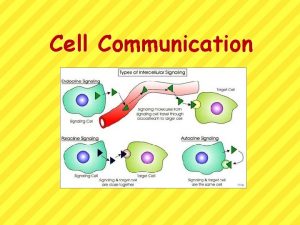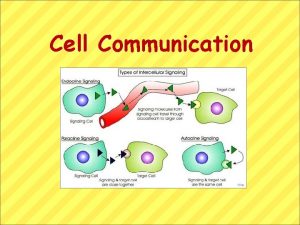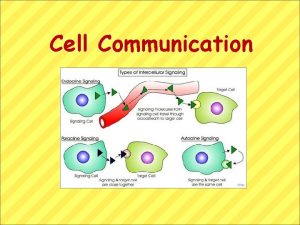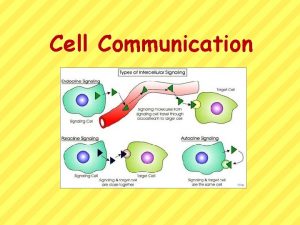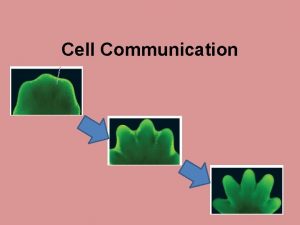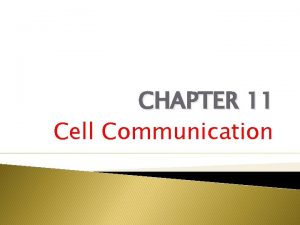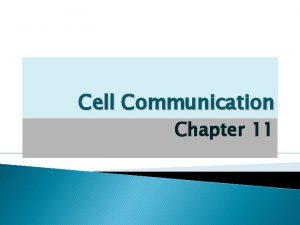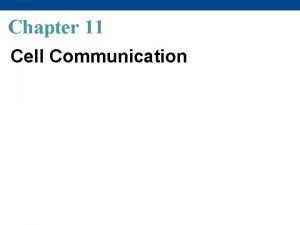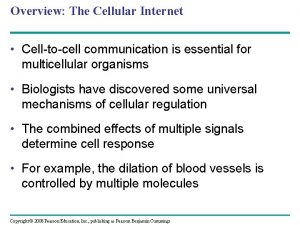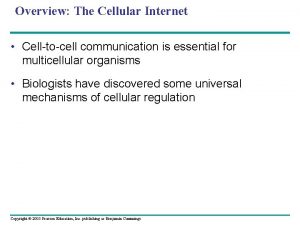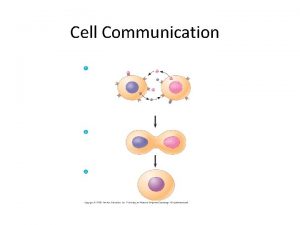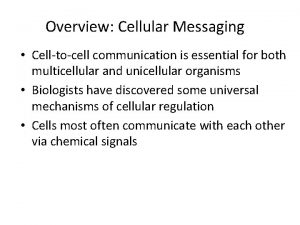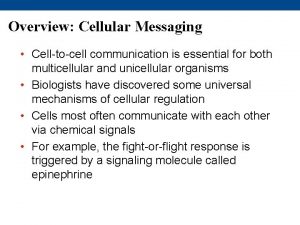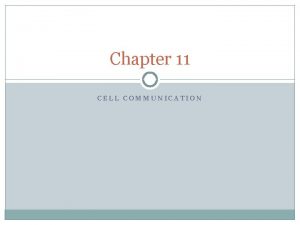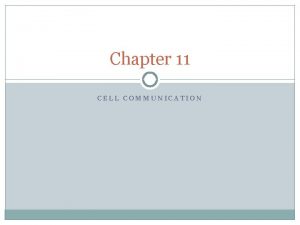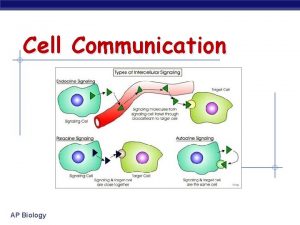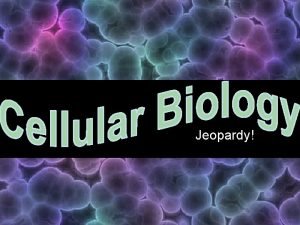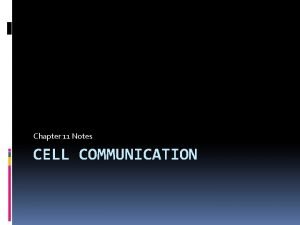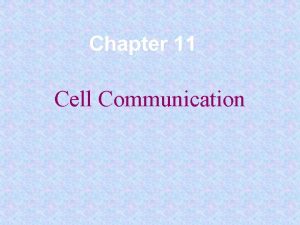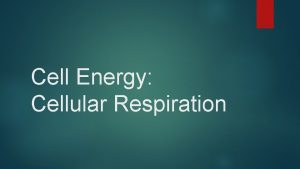Cell Communication Overview The Cellular Internet Celltocell communication































- Slides: 31

Cell Communication

Overview: The Cellular Internet ● Cell-to-cell communication is absolutely essential for multicellular organisms ● Ex. Nerve cells must communicate pain signals to muscle cells (stimulus ) in order for muscle cells to initiate a response to pain

Local and Long-Distance Signaling ● Cells in a multicellular organism (tissues, organs, systems) communicate via chemical messengers and hormones ● A hormone is a chemical released by acell in one part of the body, that sends out messages that affect cells in other parts of the organism � Hormones in animals are often transported in the blood

● Animal and plant cells �Have cell junctions that directly connect the cytoplasm of adjacent cells Plasma membranes Gap junctions between animal cells Plasmodesmata between plant cells Figure 11. 3(a) Cell junctions. Both animals and plants have cell junctions that allow molecules to pass readily between adjacent cells without crossing plasma membranes.

● In local signaling, animal cells �May communicate via direct contact Figure 11. 3(b) Cell-cell recognition. Two cells in an animal may communicate by interaction between molecules protruding from their surfaces.

● In other cases, animal cells �Communicate using local regulators Local signaling Target cell Electrical signal along nerve cell triggers release of neurotransmitter Neurotransmitter diffuses across synapse Secretory vesicle Local regulator diffuses through extracellular fluid (a) Paracrine signaling. A secreting cell acts on nearby target cells by discharging molecules of a local regulator (a growth factor, for example) into the extracellular fluid. Target cell is stimulated (b) Synaptic signaling. A nerve cell releases neurotransmitter molecules into a synapse, stimulating the target cell.

● In long-distance signaling �Both plants and animals use hormones �(ex in animals cells: estrogen and testosterone) Long-distance signaling Endocrine cell Blood vessel Hormone travels in bloodstream to target cells Target cell Figure 11. 4 (c) Hormonal signaling. Specialized endocrine cells secrete hormones into body fluids, often the blood. Hormones may reach virtually all C body cells.

The Three Stages of Cell Signaling ● Earl W. Sutherland �Discovered how the hormone epinephrine acts on cells

Sutherland’s Three Steps ● Sutherland suggested that cells receiving signals went through three processes �Reception �Transduction �Response

● Overview EXTRACELLULAR FLUID 1 Reception of cell signaling CYTOPLASM Plasma membrane 2 Transduction 3 Response Receptor Relay molecules in a signal transduction pathway Signal molecule Figure 11. 5 Activation of cellular response

Step One - Reception ● Reception occurs when a signal molecule binds to areceptor protein , causing it to change shape ● Receptor protein is on the cell surface

● The binding between signal molecule (ligand) and receptor is highly specific ● A conformational change in a receptor is often the initial transduction of the signal

Step Two - Transduction The binding of the signal molecule alters the receptor protein in some way ● The signal usually starts acascade of reactions known as asignal transduction pathway ● Multistep pathways can amplify a signal ●

●In this process o. A series of protein kinases add a phosphate to the next one in line, activating it o. Phosphatase enzymes then remove the phosphates


Small Molecules and Ions as Second Messengers ●Second messengers o Are small, nonprotein, water-soluble molecules or ions o Examples: c. AMP: Cyclic AMP; a second messenger that is created by adenylyl cyclase Ca+: high concentrations of this ion can trigger events such as muscle contraction; [also can be a first messenger/ signaling molecule that binds with a tyrosine receptor to activate


● Cell Step Three - Response signaling leads to regulation of cytoplasmic activities or transcription ● Signaling pathways regulate a variety of cellular activities

● Example of Pathway Steroid hormones bind to intracellular receptors Hormone EXTRACELLULAR (testosterone) FLUID 1 The steroid hormone testosterone passes through the plasma membrane. Plasma membrane Receptor protein Hormonereceptor complex 2 Testosterone binds to a receptor protein in the cytoplasm, activating it. 3 The hormone. DNA m. RNA receptor complex enters the nucleus and binds to specific genes. 4 NUCLEUS Figure 11. 6 CYTOPLASM New protein The bound protein stimulates the transcription of the gene into m. RNA. 5 The m. RNA is translated into a specific protein.

Termination of the Signal ● Signal response is terminated quickly by the reversal of ligand binding

Receptors in the Plasma Membrane ● There are three main types of membrane receptors: �G-protein-linked �Tyrosine kinases �Ion channel

● G-protein-linked Signal-binding site Segment that interacts with G proteins G-protein-linked Receptor CYTOPLASM ● Contains a specific binding site ● When the corresponding molecule binds here, the protein will become activated; the G protein will then become phosphorylated by the addition of GTP, which gives the G protein the energy to then activate the next molecule. Plasma Membrane GDP receptors G-protein (inactive) Enzyme Activated Receptor GDP Signal molecule GTP Activated enzyme GTP GDP Pi Cellular response Inactivate enzyme

● Receptor tyrosine kinases (Not on Quiz, however, good to know) Signal-binding site Signal molecule αHelix in the Membrane Tyrosines Tyr Tyr Tyr Tyr Receptor tyrosine kinase proteins (inactive monomers) CYTOPLASM Tyr Tyr Dimer Figure 11. 7 Activated relay proteins Tyr Tyr Tyr 6 ATP Activated tyrosinekinase regions (unphosphorylated dimer) 6 ADP P Tyr P Tyr P Fully activated receptor tyrosine-kinase (phosphorylated dimer) P Tyr P Tyr P Inactive relay proteins Cellular response 1 Cellular response 2

● Gated ion channel receptors ● A ligand binds to the ligand-gated ion channel receptor, which allows for the “gate” to open and allow ions such as Na+ and Ca+ to come into the cell and cause a cellular response ● When the ligand is removed, the gate will close Signal molecule (ligand) Gate closed Ligand-gated ion channel receptor Plasma Membrane Gate open Cellular response Gate close Figure 11. 7 Ions

Amplification of Signal

Consider this pathway: epinephrine → G protein-coupled receptor → G protein → adenylyl cyclase → c. AMP. Identify the second messenger. A. adenylyl cyclase B. G protein C. GTP D. G protein-coupled receptor E. c. AMP

Binding of a signaling molecule to which type of receptor leads directly to a change in the distribution of ions on opposite sides of the membrane? A. receptor tyrosine kinase B. intracellular receptor C. phosphorylated receptor tyrosine kinase dimer D. ligand-gated ion channel E. G protein-coupled receptor

What is most likely to happen to an animal's target cells that lack receptors for local regulators? A) They might compensate by receiving nutrients via a factor. B) They could develop normally in response to neurotransmitters instead. C) They could divide but never reach full size. D) They might not be able to multiply in response to growth factors from nearby cells. E) Hormones would not be able to interact with target cells.

When a neuron responds to a particular neurotransmitter by opening gated ion channels, the neurotransmitter is serving as which part of the signal pathway? A) receptor B) relay molecule C) transducer D) signal molecule E) endocrine molecule

Which of the following is true for the signaling system in an animal cell that lacks the ability to produce GTP? A) It would not be able to activate and inactivate the G protein on the cytoplasmic side of the plasma membrane. B) It could activate only the epinephrine system. C) It would be able to carry out reception and transduction but would not be able to respond to a signal. D) It would use ATP instead of GTP to activate and inactivate the G protein on the cytoplasmic side of the plasma membrane. E) It would employ a transduction pathway directly from an external messenger.

 Overview of cellular respiration
Overview of cellular respiration Overview of respiration
Overview of respiration Overview of cellular respiration
Overview of cellular respiration Total atp produced in cellular respiration
Total atp produced in cellular respiration Cellular transport and the cell cycle
Cellular transport and the cell cycle What type of cell performs cellular respiration
What type of cell performs cellular respiration Where in the cell does cellular respiration occur
Where in the cell does cellular respiration occur Where in the cell does cellular respiration occur
Where in the cell does cellular respiration occur Cell signaling overview
Cell signaling overview Cellular communication pogil
Cellular communication pogil What is internet
What is internet Hình ảnh bộ gõ cơ thể búng tay
Hình ảnh bộ gõ cơ thể búng tay Ng-html
Ng-html Bổ thể
Bổ thể Tỉ lệ cơ thể trẻ em
Tỉ lệ cơ thể trẻ em Gấu đi như thế nào
Gấu đi như thế nào Tư thế worm breton
Tư thế worm breton Alleluia hat len nguoi oi
Alleluia hat len nguoi oi Các môn thể thao bắt đầu bằng tiếng chạy
Các môn thể thao bắt đầu bằng tiếng chạy Thế nào là hệ số cao nhất
Thế nào là hệ số cao nhất Các châu lục và đại dương trên thế giới
Các châu lục và đại dương trên thế giới Công thức tính thế năng
Công thức tính thế năng Trời xanh đây là của chúng ta thể thơ
Trời xanh đây là của chúng ta thể thơ Mật thư anh em như thể tay chân
Mật thư anh em như thể tay chân Làm thế nào để 102-1=99
Làm thế nào để 102-1=99 Phản ứng thế ankan
Phản ứng thế ankan Các châu lục và đại dương trên thế giới
Các châu lục và đại dương trên thế giới Thơ thất ngôn tứ tuyệt đường luật
Thơ thất ngôn tứ tuyệt đường luật Quá trình desamine hóa có thể tạo ra
Quá trình desamine hóa có thể tạo ra Một số thể thơ truyền thống
Một số thể thơ truyền thống Cái miệng nó xinh thế chỉ nói điều hay thôi
Cái miệng nó xinh thế chỉ nói điều hay thôi Vẽ hình chiếu vuông góc của vật thể sau
Vẽ hình chiếu vuông góc của vật thể sau




